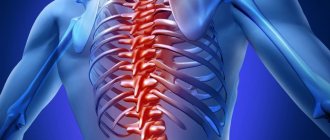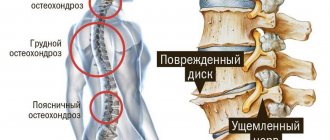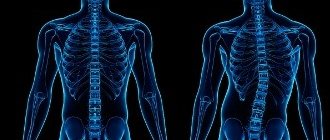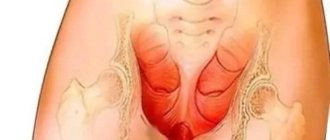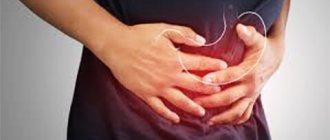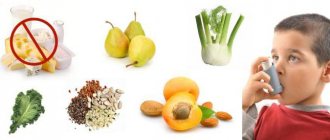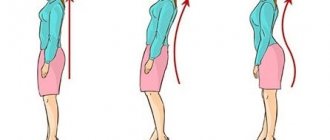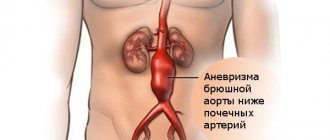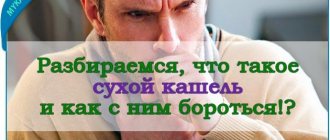Cervical osteochondrosis is a degenerative-dystrophic disease of the spine, in which the structure of cartilaginous discs and their bone base changes. Depending on the stage of the disease, deformation occurs with subsequent depletion of the vertebral bodies. As a result, blood microcirculation and nerve conduction are disrupted. Cervical osteochondrosis can be either an independent disease or combined with degenerative-dystrophic lesions of other parts of the spine.
In the international classification of diseases ICD-10, cervical osteochondrosis does not have a separate code. The pathology is designated by code M42.1 - spinal osteochondrosis in adults. The Yusupov Hospital provides a full range of diagnostics and treatment of musculoskeletal diseases. The examination is carried out using the latest equipment that meets quality and safety standards.
Causes
Doctors identify several reasons that can lead to the development of cervical osteochondrosis. These include:
- obesity;
- sedentary lifestyle;
- history of neck or spine injuries;
- excessive loads on the musculoskeletal system;
- psycho-emotional stress;
- congenital deformity of the cervical vertebrae;
- hereditary predisposition;
- scoliosis, rheumatism, flat feet;
- metabolic pathology;
- hormonal imbalance;
- hypothermia.
It is difficult to independently identify and eliminate the etiological factor. It's better to turn to professionals. Doctors at the Yusupov Hospital select an individual diagnostic complex to determine the root cause of osteochondrosis of the cervical spine. This is necessary to prescribe the correct therapy.
Expert opinion
Author:
Tatyana Aleksandrovna Kosova
Head of the Department of Rehabilitation Medicine, neurologist, reflexologist
Osteochondrosis of the cervical spine ranks second in prevalence among all degenerative-dystrophic diseases of the spine. It accounts for 30–40% of cases. The disease is considered one of the common causes of temporary disability. According to statistics, damage to the osteoarticular system leads to disability in 40% of cases.
Doctors attribute the spread of cervical osteochondrosis to changes in the lifestyle of the population. In addition, most people do not take into account the first pathological symptoms for a long time. Without treatment, the disease progresses and leads to complications. Degenerative-dystrophic changes in the cervical spine disrupt the blood supply to the brain, which is accompanied by severe symptoms. Diagnosis of osteochondrosis at the Yusupov Hospital is performed using X-rays, CT, and MRI. The condition of the brain is assessed based on the results of EEG and ultrasound of the head and neck. The selection of treatment is carried out on an individual basis. Therapy is structured in such a way as to not only stop the exacerbation of cervical osteochondrosis, but also to prevent relapses of the disease.
General symptoms
Osteochondrosis can affect one or more parts of the spine . The vertebrae of the cervical spine are most often affected. The clinical symptoms of such a deviation are directly related to the functioning of the brain. Let's consider all the main symptoms of this disease.
We invite you to watch a video about the symptoms of osteochondrosis:
Pain in the back of the head, neck and collar area
Patients often experience pain in the neck, occipital and collar areas. This occurs as a result of insufficient blood supply to parts of the brain. Deformation of the vertebrae leads to compression of the vertebral artery . Against the background of such degenerative processes, a hernia may occur.
Along with pain comes the risk of serious complications. For example, blood pressure abnormalities or persistent hearing and vision impairment. Sometimes patients experience attacks of panic and anxiety. They can last for 30 minutes. This condition is called diencephalic syndrome.
Another cause of pain is muscle spasm, which leads to decreased blood flow. The patient may temporarily lose the ability to move their neck . Severe overexertion leads to the fact that pain from the neck begins to flow into the back of the head and can further spread throughout the head. As a result of such processes, the patient suffers from severe migraines.
Noise, ringing, feeling of fullness in the ears
Decreased hearing, noise, ringing and a feeling of fullness in the ears occurs against the background of a decrease in the intensity of blood flow from the vertebral arteries to the vestibular apparatus.
This complex of symptoms is called cochlear or cochlear. Doctors cannot always associate such deviations with the development of cervical osteochondrosis.
Noise and ringing in the ears occurs when changing position or staying in one position for a long time.
Dizziness
The vertebrae of the cervical spine are quite thin, so when holding the head they are subject to severe stress. They are more susceptible to deformation than the thoracic vertebrae. As a result of the deviation, dizziness occurs, which can be :
- Systemic . There is a feeling of circular movement of the body and surrounding objects. It occurs due to a malfunction of the vestibular apparatus, muscles and receptors in the joints.
- Not systemic . The patient has a feeling of lightheadedness, stupor and uncertainty in an upright position. There is no sensation of circular rotation.
If such a symptom occurs, you should immediately consult a doctor. Reasons for emergency hospitalization of the patient:
- numbness in part of the shoulder;
- paralysis of facial muscles;
- loss of consciousness;
- Strong headache.
Displaced vertebrae and muscle spasms lead to pinched nerves that supply the brain. Due to lack of oxygen, dizziness occurs. Initially, oxygen deficiency occurs in the back of the head, since this is the center of the vestibular apparatus .
Lack of air
Lack of air during osteochondrosis can be of several types: breathing problems and lack of oxygen. Breathing becomes difficult due to pinched nerves that transmit signals from the pharynx to the esophagus.
When the vertebrae are displaced, patients experience shortness of breath. This condition often occurs during stressful situations. After their completion, normal breathing is restored. Sometimes there is a lump in the throat that cannot be washed down or swallowed.
Lack of air occurs due to a pinched nerve . As a result, a spasm of the diaphragm occurs, which is fraught with changes in the depth and rhythm of breathing. The patient becomes stuffy and has difficulty breathing. This is a serious symptom, since shortness of breath with osteochondrosis is dangerous for the development of a number of other complications. In this case, the doctor prescribes medication.
Nausea
The cervical region is the most sensitive, since its structure contains a large number of nerve fibers and vessels. There is an artery running through the neck that carries oxygen and nutrients to the brain. With cervical osteochondrosis, protrusions and intervertebral hernias form.
An insufficient amount of arterial blood flows to the posterior structures of the brain. This triggers a compensatory reaction mechanism. Narrowing of the arteries leads to increased blood pressure . The patient experiences a feeling of nausea.
If blood flow to the posterior structures of the brain is not restored, the patient will experience vomiting and loss of consciousness. Long-term impairment of cerebral circulation is fraught with the development of stroke and further disability.
Vision problems
With osteochondrosis of the neck, the patient may experience double vision, floaters and flickering. They indicate the onset of serious diseases that appear against the background of osteochondrosis. These include the following diseases:
- glaucoma;
- cataract;
- Claude Bernard-Horner disease.
- Glaucoma is accompanied by increased intraocular pressure and damage to the optic nerve. Treatment will only help achieve remission, but not eliminate the pathology completely.
- Cataracts involve destruction of the lens. This occurs due to a malfunction in the metabolic processes of the brain. The first symptom of such a disease is spots before the eyes. If treatment is not started promptly, the patient may completely lose vision.
- Claude Bernard-Horner disease . The cause of the development of the disease is hypoxia of the occipital region and damage to the optic nerve. Symptoms of the disease are worsening pupil reaction and a difference in their size. Sometimes the patient cannot close his eyelids completely. Serious problems with twilight vision are observed.
Blood pressure surges
Initially, it may seem that surges in blood pressure and osteochondrosis have nothing in common. However, it is not. With degenerative changes in the spine, the human autonomic nervous system suffers.
Jumps are observed throughout the day. This disease is not characterized by long-term hypertension. The spasmodic daily dynamics of arterial hypertension occurs due to reflex irritations of nerve endings and short-term spasms of blood vessels.
Symptoms of increased blood pressure with cervical osteochondrosis:
- headache;
- pressure surges after stress or muscle strain;
- pain in the limbs;
- low sensitivity in the collar area.
If there are sudden jumps in blood pressure and a significant deterioration in your general condition, you should seek emergency help.
Sudden fainting or syncope
Sudden fainting can occur as a result of a short-term cessation of blood flow through the vertebral arteries. If the patient has lost consciousness, he must be placed so that his legs are higher than his head. This activates blood flow to the brain. After fainting, problems with speech and movement may occur.
Pharyngeal problems
Sometimes only pharyngeal symptoms may indicate the occurrence of degenerative processes in the cervical vertebrae. They manifest themselves through:
- difficulty swallowing;
- sore throat;
- sensation of a foreign body in the throat;
- itching
Such signs are associated with injury to the neurovascular trunks that come from the spinal cord. However, these symptoms are observed not only with osteochondrosis, but also with inflammation and tumors.
Increase in body temperature
With cervical osteochondrosis, body temperature rises . This symptom occurs with the following lesions:
- vertebral artery syndrome;
- disc protrusion;
- spinal canal stenosis.
Elevated body temperature can be triggered by neurosis, neurological vomiting and fibromyalgia syndrome. Sometimes several pathological conditions are observed at once, which aggravate the symptoms of osteochondrosis.
In some cases, cervical osteochondrosis is accompanied by numbness of the face, tongue, arms and legs, swelling of the face and neck, burning of the tongue, or even inflammation of the lymph nodes.
Degree of development of cervical osteochondrosis
Cervical osteochondrosis is characterized by several stages. They determine the severity of the condition and the presence of certain clinical symptoms.
- First. In the early stages, there is a slight smoothing of the lordosis of the neck. Clinically, this is expressed in pain, which intensifies when turning the head. Patients complain of muscle tension, headache, and stiffness of movement. The first stage is treated without the use of drugs. It is enough to adhere to a certain diet and do exercises.
- Second. At this stage, instability of the cervical vertebrae appears. This is expressed in increased pain, radiating to the shoulders or arms. The pain intensifies when performing movements. The second stage is characterized by a decrease in the height of the intervertebral discs. This leads to pinched nerves. Patients complain of headaches, confusion, and fatigue.
- Third. Accompanied by severe deformation and destruction of the vertebral structure. The pain syndrome becomes permanent. Intervertebral hernias begin to form. Clinically, this is expressed in the appearance of dizziness, darkening of the eyes, and unsteadiness of gait.
- Fourth. The destroyed tissues of the intervertebral discs are replaced by connective tissue. Several segments are involved in the pathological process. Patients complain of lack of coordination, severe dizziness and headaches. There is constant noise in the ears.
Stages of development and photos
The development of osteochondrosis occurs slowly. There are 4 main stages of the disease :
- First stage . The patient feels discomfort when walking for a long time and staying in one position. Seals begin to form in the spinal discs.
- Second stage . Painful sensations occur. The doctor prescribes manual therapy and painkillers.
- Third stage . There are pronounced degenerative changes in the intervertebral discs.
- Fourth stage . The final stage of the development of the disease, in which almost all parts of the spine are affected.
At the last stage, conservative therapy will be ineffective. The doctor prescribes surgery, which will require a long recovery.
In the photo you can see how the disease manifests itself at different stages of the disease.
We invite you to watch a video about the stages of development of osteochondrosis:
Symptoms and signs
Clinical symptoms of cervical osteochondrosis of the spine are the same for all ages. Many people put off visiting a doctor because they have mild symptoms. Only when the disease becomes obsessive and is accompanied by corresponding symptoms does one seek medical help.
The equipment at the Yusupov Hospital makes it possible to accurately determine the degree of development of cervical osteochondrosis. Thanks to this, the correct treatment is prescribed, relieving symptoms in the shortest possible time. The main clinical signs of the disease include:
- neck pain accompanied by a crunching sound;
- tingling or numbness in the upper extremities;
- dizziness;
- headache;
- noise in ears;
- panic attacks;
- stiffness of movements;
- limited mobility;
- weakness, sudden loss of strength;
- nausea;
- violation of orientation in space;
- unsteady gait;
- decreased visual acuity.
Consequences of insufficient attention
If osteochondrosis in the cervical spine is not treated in time, it is dangerous.:
- chronic cerebral circulatory disorders;
- destruction of intervertebral discs;
- development of persistent combat syndrome;
- development of paralysis in the upper and lower extremities.
Physical
Physical consequences include destruction and prolapse of discs between the vertebrae and displacement of the vertebrae themselves relative to each other with collapse of the spinal cord.
With these complications, paralysis of the upper and lower extremities develops.
Neurological
Neurological consequences include the development of strokes in the vertebral artery basin, which occur acutely. Chronic consequences include the formation of encephalopathy followed by dementia.
Symptoms depending on the damaged vertebra
The cervical spine consists of 7 vertebrae. Depending on the level of damage, the corresponding symptoms are distinguished:
| Vertebra | Symptoms |
| C1 | Skin sensitivity decreases. |
| C2 | The pain syndrome is localized in the occipital and parietal areas. |
| C3 | The sensitivity of the tongue and sublingual muscles is impaired; in severe cases, speech is impaired and control over the tongue is lost. |
| C4 and C5 | Pain syndrome is determined in the shoulders and collarbones. There is a feeling of discomfort in the chest, which is often mistaken for cardiac pathology. |
| C6 | Pain is felt in the neck, shoulder blades, and forearms. Nerve damage reduces skin sensitivity. |
| C7 | The pain is localized in the neck, back of the shoulders, and upper shoulder girdle. Impairments lead to decreased reflexes and impaired hand strength. |
Complications and consequences
The most dangerous complications include:
- Protrusion of discs, which provokes the formation of a hernia.
- Disc rupture with pinched nerves and blood vessels. In this condition, the spinal cord can be compressed, which is very life-threatening.
- Radiculopathy is a disorder of the nerve roots.
- Formation of osteophytes - so-called spines on the vertebrae. As a result, paresis and paralysis often occur.
A dangerous complication of this form of osteochondrosis can be Dupuytren's contracture.
In this case, the human tendons lose their ability to stretch. As a result, the fingers become deformed and cannot function properly.
Diagnostics
Cervical osteochondrosis of the spine requires a comprehensive diagnosis. It includes:
- Collecting anamnesis of life and illness. The doctor clarifies the existing complaints, the time of their appearance, and the dynamics of severity. It is necessary to indicate the drugs that were used to alleviate the condition.
- Objective examination. After the survey, the specialist begins the inspection. The patient's skin and gait are examined. Upon palpation, painful areas are identified.
- Radiography. The first instrumental research method is radiography of the cervical spine. Most often, 2 projections are studied.
- CT, MRI. Thanks to research, it is possible to establish the source of the lesion and its exact location. Tomography allows you to assess the condition of blood vessels and nerves.
- Ultrasound Doppler. Ultrasound examination of the vessels of the head and neck makes it possible to assess their patency and the degree of stenosis.
- General blood analysis. First of all, indicators responsible for inflammation (leukocytes, ESR) are assessed.
Based on the data obtained, doctors determine the severity of cervical osteochondrosis. Doctors at the Yusupov Hospital use modern equipment that allows them to quickly and efficiently carry out any amount of diagnostic work.
Diagnosis of osteochondrosis of the cervical-collar area
To establish an accurate diagnosis, the doctor collects a history of complaints and conducts an external examination of the spine. Next clinical trials are prescribed:
- Blood analysis. Determines the presence of an inflammatory process and the general condition of the body.
- Radiography. Diagnoses structural changes in the vertebrae, determines the severity of the intervertebral lumen, as well as the presence of bone osteophytes.
- MRI and CT. Allows you to determine focal damage to osteochondral tissue in the early stages of the development of the disease.
Types of treatment
Like diagnosis, treatment of cervical osteochondrosis requires an integrated approach. The therapeutic volume is selected individually. It depends on the segment of the lesion, the severity of the disease and the severity of clinical symptoms. The main treatment methods are:
- taking medications;
- physiotherapy;
- Healing Fitness;
- massage;
- surgery.
Among the medicinal methods of treatment, several groups of drugs are used:
- Painkillers. They are used to reduce the severity of pain.
- Nonspecific anti-inflammatory drugs. Used to reduce tissue swelling and inflammatory syndrome. Prescribed in various forms (tablets, products for external use).
- Antispasmodics. Relieves spasms and reduces pain.
- Chondroprotectors. Restore the structure of intervertebral discs.
- B vitamins. Positively affect the state of the nervous system.
Methods for treating osteochondrosis at home
Treatment of cervical osteochondrosis should be comprehensive. Initially, it is necessary to relieve pain with ointments, gels, creams, and home compresses. In this case, daily self-massage and gymnastic exercises are also important. In addition, you will need to completely change your lifestyle - review your nutritional diet, move more, spend time in the fresh air, etc.
By strictly following the instructions and paying close attention to the doctor’s advice, the patient achieves good results in a short time. Carrying out self-massage saves money; using herbal decoctions and tinctures instead of certain drugs reduces the negative impact of medications on various organs. Home treatment has certain goals: to relieve the patient of pain; improve blood supply to the brain; normalize sleep; remove anxiety and irritability; stop numbness of the shoulder girdle area; improve the innervation of the cervical spine and neighboring areas.
We will learn further about how to treat osteochondrosis of the cervical spine at home.
Rubbing
Treatment of cervical osteochondrosis at home with folk remedies should begin with rubbing. This useful procedure will relieve pain, improve blood circulation in the brain, eliminate inflammatory processes, etc.
- Vodka with horseradish. The root of the plant is ground using a blender or coffee grinder. The resulting powder is mixed with vodka or alcohol in equal quantities. The medicinal composition is rubbed into the cervical area before bedtime. The duration of home therapy is 10–14 days.
- Cologne and calendula. Dried calendula flowers (200 g) are crushed. The mixture is filled with the same amount of camphor alcohol and cologne. The medicine should be infused for 2 weeks. After filtering, the composition is rubbed into the cervical area.
- Propolis and pork fat. 150 ml of pork fat is melted in the microwave. 30 g is added to it. propolis. The ingredients are mixed. Rubbing is done at night. After this, the neck is wrapped in a woolen scarf.
- Olive oil, sage and plantain. Another effective way to treat the spine with folk remedies. To prepare the medicine you will need 2 tbsp. l. sage and plantain. The herbal mixture is poured with olive oil (50 ml) and melted Vaseline (40 ml). The healing composition is applied to the cervical area and rubbed thoroughly. Homemade ointment is applied 2-3 times a day. After the procedure, the neck is wrapped in a warm scarf.
- Mix 200 ml of alcohol, ten drops of iodine, and the same amount of camphor. Add five crushed Analgin tablets. Use for rubbing the neck.
- Place fresh burdock or horseradish leaves on a steam bath. Apply warm to the neck, secure with a scarf. Keep this compress for an hour.
- Mix a spoonful of red pepper (ground), 200 ml of camphor, and the same amount of medical bile. Lubricate the neck skin with vegetable oil and apply the prepared composition.
- Take three egg whites, half a glass of vodka, a spoonful of mustard. Mix everything and apply as compresses at night.
- Mix two tablespoons of honey with vodka and aloe juice until a thick mass is obtained. Use for compresses or rubbing the neck.
- For active inflammation, you can use a compress of honey mixed in equal proportions with grated fresh potatoes.
- Boil the potatoes and mash them to a puree consistency. Mix with honey, wait until it cools a little, apply to the neck. Secure with film and a scarf.
- Mix mummy tablets with honey. Place the mixture on a bandage and apply to the neck.
- Add 3 tablespoons of salt to 200 ml of hot water. Soak gauze in the prepared liquid and apply to the neck.
Tinctures and decoctions for oral administration
Folk treatment for cervical osteochondrosis will not be complete without the use of tinctures.
- Sabelnik. Dried plant in the amount of 30 g. pour boiling water (0.5 liters). The product is infused for 3 weeks. You should drink the medicine 1 tbsp. l. three times a day. The course of therapy is 1 month.
- Mint and chamomile. 1 tbsp. l. chamomile (and the same amount of mint) is poured into 300 ml of water. Cook the mixture over low heat for 10 minutes. It is recommended to consume the composition half a glass twice a day for 21 days.
- Garlic and lemon. To begin with, citrus fruits are squeezed out (4 pcs.). 200 g is added to the resulting juice. chopped garlic. The composition is poured with boiled water and infused for 2 hours in the refrigerator. You should consume half a glass after breakfast for 3 weeks.
- A decoction of parsley roots. Parsley roots (50 g) are crushed and poured with boiling water (0.5 liters). The mixture is simmered over low heat for 1.5 hours. You should take the remedy for cervical osteochondrosis 1 tbsp. l. three times a day for 3 weeks.
- Infusion of pine buds. For tincture, buds are collected before May. The length of the bud does not exceed 20 mm. The plants are cut into mugs, carefully placed in a glass bowl, and covered with granulated sugar. Proportions: 1 bowl of kidneys equals 2 bowls of granulated sugar. The drug “arrives” in two weeks, acquiring a brownish-golden hue. Take 3 times a day, 0.005 liters. Do not swallow immediately, but keep in your mouth for 120–180 seconds. The course of treatment lasts 2–3 weeks, but the pain goes away after a couple of days.
Treatment with traditional methods should not exceed 1 month. After this period, you should take a break and then resume therapy.
Therapeutic baths
Another effective method of folk treatment for osteochondrosis of the neck is taking medicinal baths. This procedure promotes relaxation, lowering blood pressure, and relaxing the spinal column.
You should not take baths if you have cancer, hypertension, or heart disease.
The main components can be pine needles, chamomile, dry mustard, and birch leaves. Adding horse chestnut decoction to the bath shows good results.
The following baths will help against osteochondrosis of the cervical spine:
- Salt. 4–6 kg of salt should be dissolved in 500 ml. hot water. The contents are poured into a bath of warm water. The procedure lasts at least 15 minutes.
- Turpentine. This method will relieve the inflammatory process and have healing, restorative and resolving effects. One procedure will require 20–50 ml of pure turpentine.
- Needles. A good medicine for the treatment of osteochondrosis of the cervical vertebra. Ready-made pine needle extract can be purchased at a pharmacy and added to the bath.
- Chamomile. 300 gr. dry flowers of the plant are filled with 5 liters of water. The mixture must be boiled for about 20 minutes, then left for 20 minutes and filtered. You should take a chamomile bath for half an hour.
Therapeutic compresses
Many people do not know how to cure cervical osteochondrosis, which is accompanied by severe pain. Traditional homemade compresses will help with this.
- Horseradish leaves. Several leaves are doused with boiling water, then cooled and applied to the sore spot. It is recommended to wrap a woolen scarf around the top of the neck. The procedure is carried out at night. A total of 10–15 treatment sessions are needed every day. Then a break is taken and therapy resumes.
- Potatoes and honey. One large potato is grated on a fine grater, 2 tbsp is added to it. l. honey. The ingredients are mixed and applied to gauze folded in four. The compress is applied at night. The neck must be wrapped in cellophane and a woolen scarf. The duration of home therapy is 7–10 days.
- Kerosene. Gauze or a piece of cloth is soaked in kerosene and applied to the affected area. The neck is wrapped in a plastic bag and a warm scarf. The compress should be kept for 2 hours. The course of treatment is 2 weeks.
Pharmacy talkers for cervical osteochondrosis
You can treat cervical osteochondrosis at home using pharmacy talkers. These remedies will relieve inflammation and relieve even the most severe pain. So, at the pharmacy you need to purchase:
- medical alcohol;
- camphor alcohol;
- analgin;
- iodine.
300 ml of medical alcohol must be mixed with 10 ml of camphor and the same amount of iodine. 10 analgin tablets are dissolved in the resulting composition. The medicine is applied to the painful area using rubbing movements. Be careful if there are skin lesions or rashes.
Here is another chatterbox that relieves cervical osteochondrosis. Treatment with folk remedies, which include medications, must be agreed with the doctor. So, to prepare medicinal compositions you will need:
- 50 ml of diluted medical alcohol;
- 3 egg whites (beaten);
- 50 ml camphor alcohol;
- 50 gr. dry mustard.
For the second remedy:
- 150 ml of diluted medical alcohol;
- 50 ml aloe juice (purchased at the pharmacy);
- 100 ml honey.
Both mixtures are infused for 10–12 hours in a place where there is no access to the sun.
For the cervical spine, treatment is carried out as follows. In the first 3 days, composition No. 1 is used, the next 3 days - No. 2. After this, the products are alternated with the same interval for 12 days.
The compositions are applied using gauze and left until completely dry.
Applicators and massagers
Neck disease responds well to treatment if applicators are used. These devices are able to influence the area of the spinal column and correct the shape of the spine. In addition, they are used to relieve pain. The most popular among such devices is the Kuznetsov applicator. Customer reviews say that relief comes after the first use - headaches disappear, blood pressure normalizes, and dizziness goes away.
A collar massager is considered to be effective in the fight against disease. The devices are equipped with a control panel that can regulate the degree of exposure. The pain goes away within 10 minutes from the start of treatment.
Hand massagers are no less popular and effective. For cervical osteochondrosis, a device with a thermal effect is usually prescribed. One session lasts 40 minutes.
The jade vibrating neck massager has proven itself well. Its cost is quite high, but the effect of its use will not take long to arrive.
How to treat cervical osteochondrosis using self-massage?
To the question of “how to treat yourself if you have cervical osteochondrosis,” you can answer: “Self-massage.” To do this, it is recommended to sit in a comfortable chair and relax as much as possible. The massage should not be accompanied by pain, no pressure or force. Carrying out the procedure correctly will allow you to relieve pain and improve your well-being in a short period of time.
Positive sides:
- gentle pressure on the neck area prevents salt deposits and improves blood circulation;
- massage accelerates the delivery of nutrients and oxygen to tissues;
- pain decreases;
- during the procedure, the muscles of the neck and shoulder girdle relax;
- metabolic processes in the tissues of the cervical spine return to normal;
- Blood pressure often decreases to optimal levels.
A massage therapist will come to your home and conduct a session, but the procedure is quite expensive; a long course of massage for osteochondrosis is not cheap. Patients can perform self-massage without financial costs with the same benefits.
The task is to study massage techniques, identify active points that must be massaged, and learn about areas that should not be affected. Self-massage techniques are simple, you need to act carefully, without sudden movements.
Basic Rules:
- direction of movement - from the spine to the periphery;
- massage is carried out only with fingers, without additional devices;
- strong pressure is excluded: only soft, delicate pressure;
- movements are smooth: haste, sudden pressure is unacceptable.
Basic techniques:
- stroking;
- kneading;
- trituration.
Treatment area:
- muscles of the lateral and posterior neck;
- back of the head
So, how to treat osteochondrosis of the cervical spine using self-massage? The session begins with stroking (in fact, this is where it ends). The left hand is placed on the right shoulder. The head turns to the left. The movements start from the neck and end with the shoulder. Then the hand changes and the head turns in the opposite direction. Stroking lasts about 6–7 minutes.
- Trituration. The movements are carried out in a circular motion from the neck to the shoulder. 3-4 approaches for each side are enough. We turn our heads in the same way as in the previous case.
- Tingling. In the same direction, we begin to carry out movements that resemble pinching. Each side should be massaged for 2-3 minutes.
- Pat. In this case, the palm should imitate a boat. This same “boat” will carry out the patting movements. The direction is the same.
Self-massage ends with stroking.
Video “Self-massage of the neck”
Effective exercises
Traditional methods of treatment should be used along with self-massage and exercise.
Gymnastics is best done in the morning after waking up. If exercises cause dizziness, they should be performed in a sitting position.
- The back is straight. Hands are placed behind the head and fingers crossed. Start pressing on your head with your palms. The head should resist.
- Place your right palm on your right temple. Start pressing on your temple. The head must resist. Do the same with the opposite side.
- Head tilts forward and backward. Repeat 20 to 40 times.
- Tilt your head to the sides. Repeat from 20 to 60 times.
- Turn your head to the right and left from twenty to forty times.
- Head rotation - 40 times.
Position: sitting on the floor, knees to chest. Place your head on your knees, stretching your neck. Hold the position for twenty to fifty seconds.
Repeat the exercises in 3 sets. Each of them must last at least 20 seconds.
After this, tilt your head to the right - left, forward - back 20 times each. Gymnastics should be done daily. You can include any physical elements. The main thing is that there are no sudden movements or jerks.
Taking folk remedies for osteochondrosis should be combined with proper nutrition. You should forget about fatty and spicy foods. The prohibited category includes pork, meat broths, alcohol, coffee, and strong tea. The diet should include only healthy foods - fruits, vegetables, fish and lean meats, fermented milk products and plenty of water.
We invite you to watch a video with a full range of exercises for cervical osteochondrosis:
Acupuncture
Acupuncture can really help with osteochondrosis. This is explained by the fact that there are quite a lot of active points along the spine that can be affected by needles. Degenerative processes in the intervertebral discs lead to the compression of blood vessels and nerve endings, resulting in the formation of so-called trigger points - painful and nodular seals. It is the presence of such points that is associated with back pain characteristic of osteochondrosis. These points are very sensitive to mechanical influence. Therefore, inserting needles into trigger points can relieve tension and relieve pain.
Unlike many other treatment methods, acupuncture can be used even during exacerbations and severe pain. This method of treatment has practically no contraindications, it does not provoke side effects (for example, allergies, as with drug treatment).
Acupuncture activates the production of adrenal hormones, which makes the vascular walls less permeable and regulates blood production. A combination of acupuncture and massage can be very effective.
You should not expect miracles from acupuncture, since it will not provide a complete cure, because this disease is caused by a combination of many factors. However, in 5-10 sessions you can relieve pain and alleviate the patient’s condition. It is advisable to conduct 20 - 30 sessions per year, divided into 2-3 courses. This will help support the body.
It is very important what methods of influence the doctor uses. If these are the principles of acupuncture, then only muscle relaxation will be achieved, which will lead to some pain relief for a certain period of time. If the doctor works according to the principles of Chinese medicine, in addition to relaxing the muscles, the body’s self-healing mechanisms will be launched. That is, the result will be more stable and long-lasting.
Treatment with needles is an individual process, so an unqualified doctor will not only not help, but can even cause harm and cause an exacerbation of the disease.
Diet food
A diet for this disease creates the necessary “background” for successful treatment and reduces the likelihood of side effects of drug therapy.
The body must receive a sufficient amount of proteins, fats, carbohydrates and biologically active substances. Protein in the diet should be at least 80 g, fat: 30 g. vegetable and 50 gr. animal, the level of carbohydrates should be reduced to 300 - 400 grams, it is better to do this at the expense of sugars. In addition, you need to reduce the amount of salt consumed (no more than 3 g per day) and liquid. Take food often, but in small portions: 5-6 times a day. You should avoid spicy, smoked, alcoholic, strong tea and coffee.
It is important to maintain sufficient amounts of vitamins P, PP, C, B1 and B2. During the cold season, it is advisable to take multivitamin preparations.
The total weight of food per day is about 2 kilograms; liquids per day can be consumed about a liter. The nutritional value of the diet should be within 2500 kcal.
- You should give preference to vegetable soups and borscht without broth or with weak broth no more than once a week.
- Meat and fish should be boiled or baked, choosing low-fat varieties. You can fry only after cooking.
- The number of eggs is limited to three per week. It is not advisable to eat hard-boiled eggs.
- People with increased body weight should avoid baking. It is better to eat gray or black bread, with bran or whole grain.
- You can use any vegetables, reducing only the proportion of mushrooms. If indicated, you should also reduce the amount of legumes and spinach.
- Unlimited fruits, except grapes.
- Whole grain porridge is healthy. If you are obese, reduce the proportion of pasta and cereals.
- Low-fat dairy products and cheeses are very healthy.
- You should limit the amount of animal fats in your diet.
- Sweets are allowed to be consumed up to 30 grams. per day.
- It is advisable to drink weak tea, chicory drinks, juices, herbal infusions. You should completely give up alcohol.
- Very healthy: dried fruits, as well as vegetables rich in potassium (bananas, eggplants, potatoes, cabbage) and magnesium (soybeans, buckwheat, millet, walnuts).
Physiotherapy
Regular exercise therapy will not only relieve the severity of pain, but also have a preventive effect. Thanks to physical exercise, the muscle corset is strengthened, blood circulation in the affected area is improved, and the load in the affected area is reduced. Experienced instructors working at the Yusupov Hospital develop individual therapy programs for each patient. This helps to quickly and effectively get rid of the symptoms of cervical osteochondrosis. The selected course can be repeated at home.
How to treat it?
Treatment of osteochondrosis is carried out in a hospital or day hospital. Mild variants are treated in outpatient settings.
Which doctor should I contact?
Neurologists and orthopedists and traumatologists treat osteochondrosis . Cases requiring surgical care are managed by neurosurgeons. At the final stage of treatment, rehabilitation specialists are involved.
What to do if a pregnant woman has a second degree anomaly?
Pregnancy adversely affects the course of cervical osteochondrosis, as calcium is washed out of the bones.
Pregnant women with Kimmerli's anomaly, concomitant with SCH, often experience disturbances in the blood supply in the vertebral artery. In the second degree, severe dizziness occurs. With deterioration, transient ischemic attacks occur. Coordination disorders occur and speech suffers.
In this case, the pregnancy is managed jointly with a neurologist. The underlying disease is treated and a gentle regimen is recommended .
Is there a danger to the fetus?
It is important to prevent loss of consciousness, which can be dangerous for the pregnant woman and the unborn child. Possible injury to the fetus if it falls. In general, osteochondrosis does not have a significant effect on the course of pregnancy.
Medicines
Symptomatic therapy is most often used for treatment . It is aimed at:
- pain relief;
- improvement of peripheral blood circulation;
- relieving inflammation;
- improvement of metabolism in the disc and nerve roots.
The following drugs are used for this purpose:
- non-steroidal anti-inflammatory drugs (Nise, Nimesil, Airtal);
- vasoactive drugs (Trental, Eufillin);
- painkillers (Ketanov, Xefacam);
- central muscle relaxants (Sirdalud, Baclofen);
- drugs that improve metabolism (Milgamma, Neuromultivit).
In severe cases, glucocorticoids are prescribed to relieve inflammation and swelling.
Preparations for the restoration of joint cartilage tissue
In order to restore metabolism in the intervertebral disc and compensate for the deficiency of building material for it, glucocorticoids are prescribed. Taking these drugs can stop the destructive process in cartilage. This group is represented by the following drugs :
- Aflutop;
- Teraflex;
- Artron;
- Chondroxide;
- Movex.
They are accepted for a long time, at least six months. As prescribed by a doctor, the course of treatment can take several years .
Exercises
Exercises for the cervical spine should be performed under the guidance of an experienced instructor and the supervision of a rehabilitation specialist. They are aimed at improving blood circulation and increasing the range of active movements in the neck.
There are features of exercise therapy for this disease:
- one set of exercises is performed for no more than two minutes;
- tilting and turning the head is prohibited;
- Rotation of the neck is not recommended;
- perhaps a subtle nod.
Correct implementation of the exercise therapy complex can significantly improve the condition.
Below is a visual video about the exercises recommended for cervical osteochondrosis:
Massage
Neck massage is performed carefully, while sitting or lying down . The neck and collar area is covered. You must contact a qualified specialist, otherwise serious complications may occur.
Self-massage is performed without unnecessary effort. Stroking and circular rubbing are used.
We invite you to watch an informative video about proper self-massage at home:
Treatment at home
Before starting treatment, be sure to consult your doctor . At home, you can use patches, various types of ointments and gels to alleviate the course of the disease. These are the following drugs:
- Fastum gel;
- Diclofenac;
- Voltaren;
- Dolobene.
You can use mild painkillers such as Nurofen.
Folk remedies
Various compresses and rubbing are used to treat osteochondrosis with folk remedies. The following tools are popular :
- horseradish leaves;
- kerosene;
- turpentine;
- boiled potatoes mashed with honey.
These procedures are carried out up to fifteen times, after a month they can be repeated
Ointments
For osteochondrosis, ointments with a warming effect that improve blood circulation are used . The most effective are considered:
- Finagon;
- Ethkamon;
- Capsicam;
- Heparin ointment;
- Ben is gay.
These drugs are used only as part of complex therapy; they do not replace the main treatment.
Massagers
During the follow-up phase, various massagers are used . They are not used in the acute phase (what are the causes of exacerbation and how to relieve it at home?). For this purpose the following are used:
- various types of electric massagers;
- Kuznetsov applicator;
- warming massagers.
other methods
It is widely used in the complex treatment of osteochondrosis.:
- hirudotherapy;
- acupuncture;
- manual therapy;
- kinesiotherapy;
- blockades
All procedures must be carried out exclusively by a specialist.
Massage
A properly performed massage of the cervical-collar area can alleviate the condition, relieve muscle spasms, and improve mobility. Restrictions for the procedure are:
- pathology of the cardiovascular system in the stage of decompensation;
- tumor formations;
- skin diseases;
- exacerbation of chronic somatic pathologies;
- osteomyelitis.
Experienced massage therapists work at the Yusupov Hospital. The course of treatment is selected individually. Its average duration is 10-15 sessions.
Prevention
In order to prevent the development or exacerbation of cervical osteochondrosis, it is necessary to regularly engage in prevention. Doctors recommend:
- to live an active lifestyle;
- maintain posture;
- strengthen the muscles of the back and neck;
- adhere to a balanced and rational diet;
- sleep in the correct and comfortable position;
- Take breaks periodically if work involves prolonged sitting.
If the first symptoms of cervical osteochondrosis occur, it is recommended to consult a doctor. Specialists at the Yusupov Hospital have been diagnosing and treating diseases of the musculoskeletal system for many years. All studies and therapy are prescribed taking into account international standards. To get an appointment with a doctor, you must call in advance. Hospital administrators will answer all your questions.
Why does osteochondrosis appear?
Although traditional medicine considers degenerative changes in the intervertebral discs of the cervical spine to be a disease, from the point of view of osteopathy, this is only a manifestation of deeper disorders in the body.
Thus, the true causes of cervical osteochondrosis are:
- Muscle spasms. Spasmodic reactions of the muscles of the back, chest, and abs can lead to certain areas of the body becoming very tense. As a result, the overall equilibrium position of the body is disrupted, causing a change in the position of the spine. Deformations can affect the cervical region or other parts of the spinal column, causing osteochondrosis of the thoracic, cervical, and lumbar regions.
- Poor posture. Scoliosis, stoop, round back, kyphosis and other postural disorders, even if they are minor, cause serious imbalance in the spinal column. As a result, the load on the intervertebral discs is distributed unevenly, which provokes their deformation and increased wear. The vertebrae begin to come closer together, causing pinching of the nerve processes, and cervical osteochondrosis develops quite quickly. Posture disorders caused by changes in the natural position of the ribs have similar consequences.
- Violation of innervation. A decrease in the sensitivity of the nerve roots leads to pathological changes in their structure, as a result of which the displacement and deformation of the cervical vertebrae goes unnoticed by the patient. After all, there is no pain due to sensory disturbances.
- Diseases of internal organs. Incorrect position of internal organs, their displacement and lowering due to various dysfunctions leads to disruption of the overall balance in the body. As a result, this acutely affects the position of the spinal column - the cervical and lumbar vertebrae are displaced and deformed, leading to the corresponding types of osteochondrosis.
- Impaired blood supply. Since the vertebral discs do not have a direct connection with the circulatory system, they receive nutrition from surrounding tissues. Impaired blood supply to the cervical spine leads to the fact that the discs do not receive enough fluid to rehydrate (restore their shape by absorbing moisture) and renew cartilage tissue. As a result, their wear accelerates, and a decrease in the distances between the cervical vertebrae is observed, leading to osteochondrosis.
In general, osteochondrosis of the cervical spine develops due to exposure to unfavorable external factors that disrupt the natural equilibrium position of the spinal column and other systems of the human body. Often these disorders do not become noticeable immediately, and cervical osteochondrosis progresses, leading to serious consequences. Therefore, it is so important to regularly visit an osteopath, who can correct the root causes that caused osteochondrosis of the cervical vertebra, and not prescribe treatment for symptoms, as traditional medicine does.

